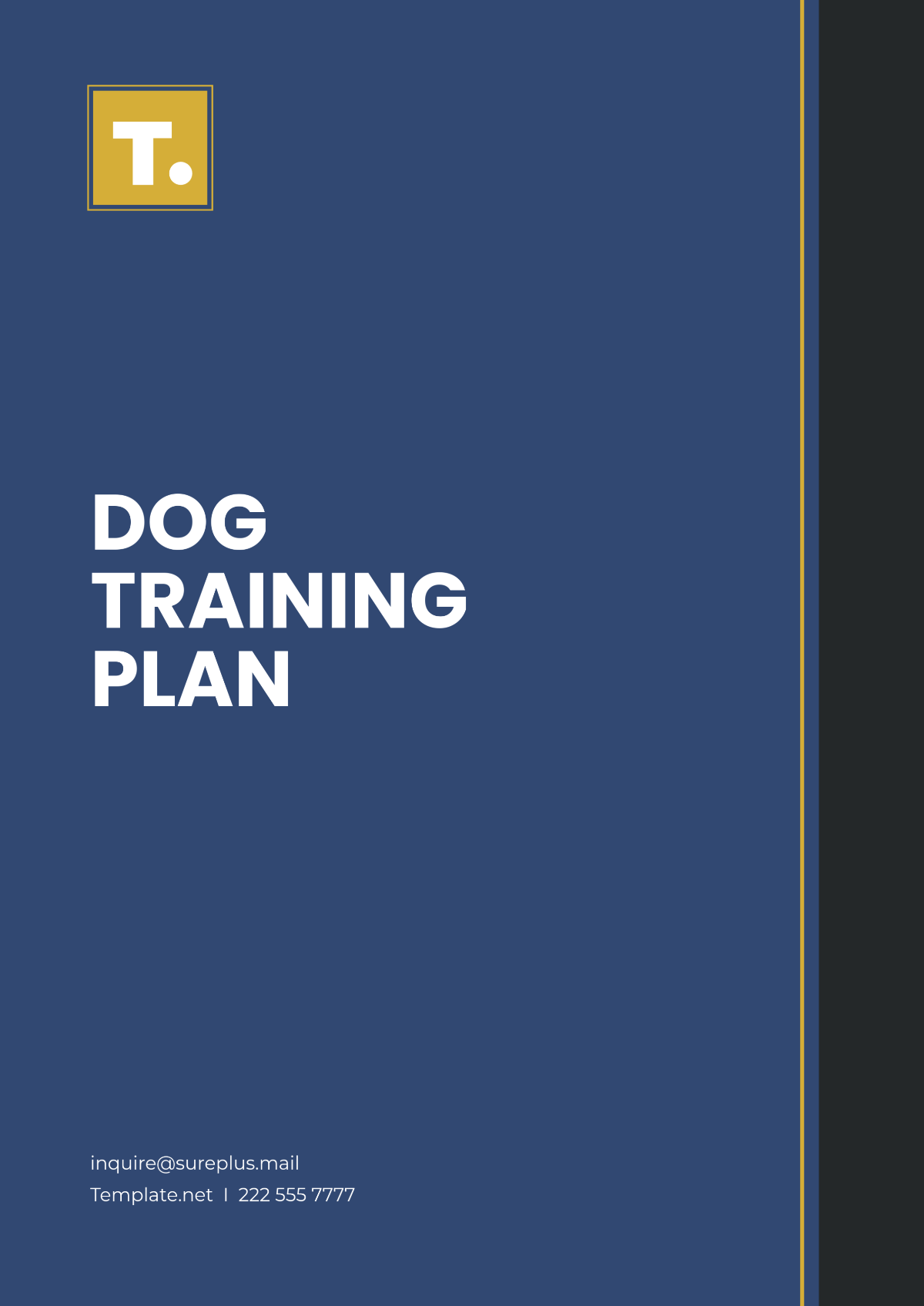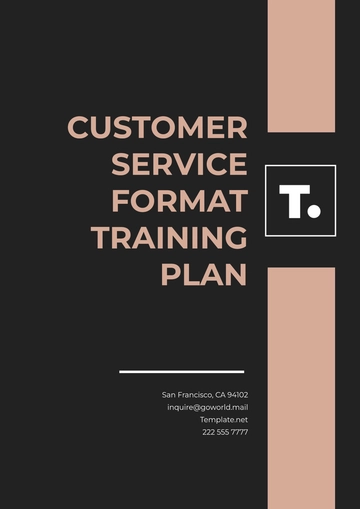Free Dog Training Plan

Written by: [Your Name]
I. Introduction
Welcome to the [YOUR COMPANY NAME] This plan is designed to help you teach your dog essential commands that are fundamental to good behavior. Whether you are a new dog owner or looking to refresh your dog's training, this guide will provide you with a structured approach to achieve success.
II. Training Goals
The primary goals of this training plan are:
To teach your dog the basic commands: sit, stay, come, and heel.
To improve communication between you and your dog.
To establish a foundation for further training and positive behavior.
III. Training Schedule
The training plan is structured over 6 weeks, with sessions held three times a week. Each session lasts approximately 30 minutes. Below is a sample schedule:
Week | Day | Focus | Activity |
|---|---|---|---|
Week 1-2 | Monday | Sit | Introduction to "Sit" command |
Wednesday | Sit | Reinforcement of "Sit" with positive reinforcement | |
Friday | Sit | Practice "Sit" in different environments |
Week | Day | Focus | Activity |
|---|---|---|---|
Week 3-4 | Monday | Stay | Introduction to the "Stay" command |
Wednesday | Stay | Short duration "Stay" practice | |
Friday | Stay | Gradually increase the duration and distance for "Stay" |
Week | Day | Focus | Activity |
|---|---|---|---|
Week 5 | Monday | Come | Introduction to "Come" command |
Wednesday | Come | Practice "Come" with short distances | |
Friday | Come | Practice "Come" with distractions |
Week | Day | Focus | Activity |
|---|---|---|---|
Week 6 | Monday | Heel | Introduction to "Heel" command |
Wednesday | Heel | Practice "Heel" with leash walking | |
Friday | Heel | Practice "Heel" in different environments |
IV. Training Techniques
Command | Steps |
|---|---|
Sit | Hold a treat close to your dog's nose. |
Move your hand up, allowing the dog’s head to follow the treat and their bottom to lower. | |
Once in a sitting position, say "Sit," give the treat, and share affection. |
Command | Steps |
|---|---|
Stay | First, command your dog to "Sit." |
Open your palm in front of you and say "Stay." | |
Take a few steps back. If they stay, reward them. | |
Gradually increase the number of steps before rewarding. |
Command | Steps |
|---|---|
Come | Put a leash and collar on your dog. |
Go down to their level and say, "Come," while gently pulling on the leash. | |
When they get to you, reward them with a treat and affection. |
Command | Steps |
|---|---|
Heel | With your dog at your side, hold a treat in your hand. |
Walk forward, encouraging your dog to stay close by saying "Heel." | |
If they move ahead, stop walking. When they come back to your side, continue walking and reward them. |
V. Progress Tracking
Use the following template to track your dog's progress:
Week | Command | Progress Notes |
|---|---|---|
1 | Sit | |
2 | Sit | |
3 | Stay | |
4 | Stay | |
5 | Come | |
6 | Heel |
VI. Resources & Materials
A. Training Tools:
The list includes a leash for guiding and controlling the dog, a collar for identification and attachment, treats to reward positive behavior during training, a clicker for marker training that provides a consistent way to communicate with the dog, various toys for playtime and mental stimulation, agility equipment to enhance physical fitness and skills, and a training journal to record progress and keep track of schedules and sessions.
B. Recommended Reading:
Books: "The Art of Raising a Puppy" by Monks of New Skete, "Don't Shoot the Dog" by Karen Pryor, and "The Other End of the Leash" by Patricia McConnell.
C. Support:
Contact information: [Your Company Name], [Your Company Address]
Phone: [Your Company Number]
Email: [Your Email
Website: [Your Company Website]
Follow us on social media: [Your Company Social Media]
VII. Evaluation & Progress Monitoring
A. Weekly Progress Reports:
Keep a detailed record each week of any achievements reached, challenges encountered, and noticeable changes in behavior. Based on this information, make any necessary adjustments to the methods and tools used for training.
B. Monthly Evaluations:
At the end of each month, it's crucial to conduct a comprehensive review of the dog's progress, examining all aspects of their training, so that any needed changes can be made to the training plan to keep it effective and suited to the dog's needs.
C. Feedback:
Actively seek and welcome feedback from both dog owners and professional trainers to gather diverse insights and experiences. Utilize this valuable input to refine, enhance, and tailor future training plans to better meet the specific needs and preferences of dogs and their handlers.
VIII. Conclusion:
This Dog Training Plan provides a systematic approach to achieving a well-trained, obedient, and happy dog. By following this plan, you will foster a strong bond and ensure a positive experience for both you and your canine companion. If you need any further assistance or have questions, please reach out to [Your Company Name] at [Your Company Number] or [Your Email].
- 100% Customizable, free editor
- Access 1 Million+ Templates, photo’s & graphics
- Download or share as a template
- Click and replace photos, graphics, text, backgrounds
- Resize, crop, AI write & more
- Access advanced editor
Unlock the secret to a well-trained pup with Template.net's Dog Training Plan Template. Crafted for ease, it's editable and customizable, tailoring to your furry friend's needs. This AI Editable Tool simplifies the process, ensuring a seamless experience. From obedience to agility, this template guides you every step, unleashing your dog's full potential. A must-have for any proud pet parent.
You may also like
- Finance Plan
- Construction Plan
- Sales Plan
- Development Plan
- Career Plan
- Budget Plan
- HR Plan
- Education Plan
- Transition Plan
- Work Plan
- Training Plan
- Communication Plan
- Operation Plan
- Health And Safety Plan
- Strategy Plan
- Professional Development Plan
- Advertising Plan
- Risk Management Plan
- Restaurant Plan
- School Plan
- Nursing Home Patient Care Plan
- Nursing Care Plan
- Plan Event
- Startup Plan
- Social Media Plan
- Staffing Plan
- Annual Plan
- Content Plan
- Payment Plan
- Implementation Plan
- Hotel Plan
- Workout Plan
- Accounting Plan
- Campaign Plan
- Essay Plan
- 30 60 90 Day Plan
- Research Plan
- Recruitment Plan
- 90 Day Plan
- Quarterly Plan
- Emergency Plan
- 5 Year Plan
- Gym Plan
- Personal Plan
- IT and Software Plan
- Treatment Plan
- Real Estate Plan
- Law Firm Plan
- Healthcare Plan
- Improvement Plan
- Media Plan
- 5 Year Business Plan
- Learning Plan
- Marketing Campaign Plan
- Travel Agency Plan
- Cleaning Services Plan
- Interior Design Plan
- Performance Plan
- PR Plan
- Birth Plan
- Life Plan
- SEO Plan
- Disaster Recovery Plan
- Continuity Plan
- Launch Plan
- Legal Plan
- Behavior Plan
- Performance Improvement Plan
- Salon Plan
- Security Plan
- Security Management Plan
- Employee Development Plan
- Quality Plan
- Service Improvement Plan
- Growth Plan
- Incident Response Plan
- Basketball Plan
- Emergency Action Plan
- Product Launch Plan
- Spa Plan
- Employee Training Plan
- Data Analysis Plan
- Employee Action Plan
- Territory Plan
- Audit Plan
- Classroom Plan
- Activity Plan
- Parenting Plan
- Care Plan
- Project Execution Plan
- Exercise Plan
- Internship Plan
- Software Development Plan
- Continuous Improvement Plan
- Leave Plan
- 90 Day Sales Plan
- Advertising Agency Plan
- Employee Transition Plan
- Smart Action Plan
- Workplace Safety Plan
- Behavior Change Plan
- Contingency Plan
- Continuity of Operations Plan
- Health Plan
- Quality Control Plan
- Self Plan
- Sports Development Plan
- Change Management Plan
- Ecommerce Plan
- Personal Financial Plan
- Process Improvement Plan
- 30-60-90 Day Sales Plan
- Crisis Management Plan
- Engagement Plan
- Execution Plan
- Pandemic Plan
- Quality Assurance Plan
- Service Continuity Plan
- Agile Project Plan
- Fundraising Plan
- Job Transition Plan
- Asset Maintenance Plan
- Maintenance Plan
- Software Test Plan
- Staff Training and Development Plan
- 3 Year Plan
- Brand Activation Plan
- Release Plan
- Resource Plan
- Risk Mitigation Plan
- Teacher Plan
- 30 60 90 Day Plan for New Manager
- Food Safety Plan
- Food Truck Plan
- Hiring Plan
- Quality Management Plan
- Wellness Plan
- Behavior Intervention Plan
- Bonus Plan
- Investment Plan
- Maternity Leave Plan
- Pandemic Response Plan
- Succession Planning
- Coaching Plan
- Configuration Management Plan
- Remote Work Plan
- Self Care Plan
- Teaching Plan
- 100-Day Plan
- HACCP Plan
- Student Plan
- Sustainability Plan
- 30 60 90 Day Plan for Interview
- Access Plan
- Site Specific Safety Plan





























